Report
FOLENS Seminar December 2011:
Sustainable Energy Strategies: Challenges of local communities for local energy generation for local consumption –Visit to Iida and Ina Cities, Nagano Prefecture (The 3rd FOLENS International Symposium Excursion)
Student's Reports:![]() Yuya Miyazaki,
Yuya Miyazaki, ![]() PYONE Win Win,
PYONE Win Win, ![]() Long Zhao,
Long Zhao, ![]() Miu_Kamimura
Miu_Kamimura
![]() Co Thi Kinh,
Co Thi Kinh, ![]() Vo Thi Minh Tam,
Vo Thi Minh Tam, ![]() Mudan HOU,
Mudan HOU, ![]() Cattleya Chutteang,
Cattleya Chutteang,
![]() Kazuhiro AOI,
Kazuhiro AOI,
![]() Shaofeng Gong,
Shaofeng Gong, ![]() Yuta Numajiri,
Yuta Numajiri,
![]() Raj Kumar Banjara,
Raj Kumar Banjara,
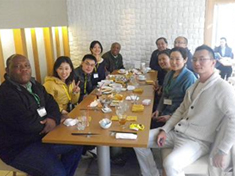 |
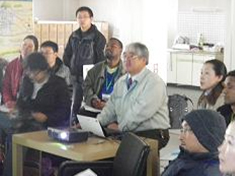 |
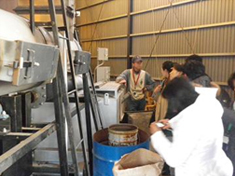 |
| Delicious lunch of locally produced vegetables at Natural Kitchen TESSHIN | Lecture “Change our energy, now!” by President Akihiro Hara of Ohisama Shinpo Energy | Boiler reusing mushroom bed wastes (Sakura Farm) |
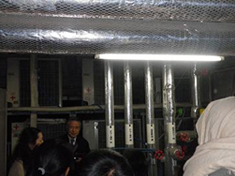 |
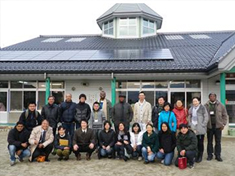 |
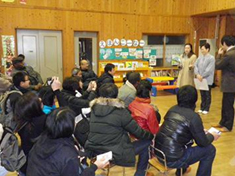 |
Heat pump facility utilizing overflowed hot spring (Sangitei Honkan Hotel) |
In front of solar panels installed at a nursery rooftop overcoming difficulties set by conventional regulations (Kanae Mitsuba Nursery) |
Talk by Principal about teachers’ environmental awareness development and environmental education to children (Kanae Mitsuba Nersury) |
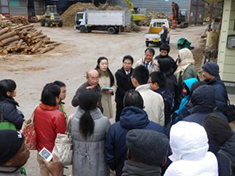 |
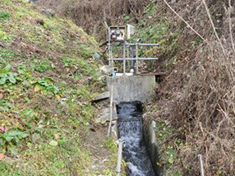 |
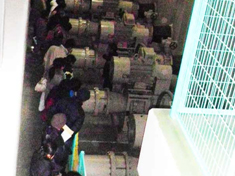 |
| Promotion of wood pellets utilizing thinned woods as an alternative energy source (Nanshin Biomass Cooperative/ Nanshin Chip Center) | Micro hydro power generation equipment installed by a local group (Inadani Natural Energy Study Group/ Hasenakayama Community Power Station) | Small-scale hydro power station feasibly operated by a private company (Mibugawa Power Company, No.4 Power Station) |
The FOLENS Seminar in December 2011 was a field trip to Iida and Ina Cities of Nagano Prefecture with an objective to learn about challenges of local communities for the local generation of energy for the local consumption. This was also organized as an excursion for the 3rd International Symposium of FOLENS held on 2-3 December, thus, professors of the E&R Bases and a partner university (Dr. John Ofosu-Anim of University of Ghana, Dr. Le Viet Dung of Can Tho University of Vietnam, Dr. Hou Hong of Chinese Research Academy of Environmental Sciences, Dr. Tiwa Pakoktom of Kasetsart University of Thailand, and Dr. Samuel Nii Odai of Kwame Nkrumah University of Science and Technology, Ghana), a panelist (Ms. Ayumi Kinezuka of Hitoto Shizenwo Tsunagukai) also participated. With 21 students (including 19 FOLENS students) and 5 TUAT/FOLENS faculty members, in total 32 participants joined the trip.
The trip forms the core part of a seminar series from November to January on the theme “Sustainable Energy Strategies: Challenges of Local Communities for Local Energy Generation and Consumption”. In the discussions in FOLENS Seminars in April and May, held in the middle of confusion and shock after the Great East Japan Earthquake and Fukushima Daiichi Nuclear Power Plant Disaster, we decided to set “energy” as the main topic of our learning this year. For this trip, we particularly focused on “the local generation for local consumption” or CHISAN CHISHO, a key concept in sustainable energy policies. The trip was planned for us to visit communities that make challenges, listen to stories of the people there, observe actual practices of renewable energy utilization, and learn about philosophies, strategies, and technological/ institutional possibilities and issues for local-scale sustainable energy generation.
Day 1:
In the bus, as an opening activity for the two-day trip, all the students and faculty who gathered from various research areas and countries expressed “what I expect to learn from this trip”. Topics raised included “practices that I cannot find in my country”, “the power inside the people”, “biomass”, “ways of using energy in a local community and how that model can be applied to my country”, and “how sustainable energy policies can be realized without governmental subsidies”.
Next, a series of mini-lectures followed. Assoc. Prof. Furihata of TUAT, a special guest, introduced the background of Iida City, which is widely known for its people’s active learning practices utilizing Community Learning Centers or KOMINKAN. It showed that the efforts of Iida City to create a “sustainable cultural city” are supported by its empowerment process of its residents over time. Assoc. Prof. Sagehashi of FOLENS talked about the basic of energy, and FOLENS students, Mr. Yuya Miyazaki and Mr. Zhao Long respectively explained about biomass, one of the important renewable energy sources, and a heat pump, one of the energy-saving technologies.
The first destination in Iida was “Ohisama Shinpo Energy”, which promotes energy shift from communities in collaboration with local people and government. President Akihiro Hara gave a lecture titled “Natural energy use promotion intentionally funded by citizens –Change our energy, now!”, with explanation about their innovative “Citizen Fund” system, how they have come to realize it and how successful it has been. The “Citizen Fund” is a scheme to gather investments from people to finance the initial costs to install renewable-energy-generation or energy-saving equipments such as solar panels. The investments are to be returned with interests after collecting fees for electricity produced with these equipments from the users. President Hara also talked about the future vision, introducing the company’s ultimate goal to “decide and realize our desirable future”. After the lecture, both faculty and students were desperate to ask questions from various aspects, such as solar technologies, a scheme to sell electricity, PR and extension of Citizen Fund, possibility of sustainable energy business without governmental subsidies, President's own experience in community learning activities, and more. After a prolonged Q&A session, we also observed energy-saving appliances installed in their office.
Mr. Taniguchi, staff, and Mr. Kiyokawa and Mr. Koyama, interns of Ohisama Shimpo Energy, accompanied us to visit some of their installment sites. The first was Sakura Farm, a mushroom producing farm, which has introduced a boiler to utilize mushroom bed wastes instead of oil as a resource. President Toshimi Sakurai told us his motivation, achievements, difficulties, and issues. The next site was Sangitei Honkan, a spa hotel. President Kojima introduced their heat pump utilizing overflowed hot spring water and a boiler using wood wastes. This hotel was also our accommodation for the night, and provided international participants an opportunity to experience Japanese-style rooms and a hot spring public bath.
Day 2:
The second day started with a visit to Kanae Mitsuba Nursery, accompanied by Mr. Taniguchi, Mr. Kiyokawa, and Mr. Koyama again. Here, Ohisama Shimpo Energy installed solar panels on its rooftop and receives electricity fees from the nursery. Usually in Japan, implementation of such a scheme is difficult if not impossible, due to rigid regulations. However, flexible support of Iida City enabled such a path-breaking challenge. Principal of the nursery also explained about the awareness development of its staff under the City’s initiatives for creating an “Environmental Cultural City” and environmental education to the children and their family after the solar panel installment.
After these Ohisama Shinpo Energy sites, the next destination was Nanshin Biomass Cooperative established by five local companies to promote wood pellet production and consumption. Its Director, Mr. Hajime Iguchi, President of Nanshin Chip Center, showed us his pellet factory, while telling us his passion for mountains and nature, hardships and achievements he has had with the wood pellet business, and the vision for the future. Students, particularly those from outside of Japan, questioned about land ownership, logging rights, and forest management practices in Japan. The differences became apparent between Japan where thinning of woods has been an urgent task to revitalize the forestry and the forest environment, and areas where deforestation due to over-logging has been the major problem.
In the afternoon, we moved to Ina City, and first visited Hasenakayama Community Power Station where Inadani Natural Energy Study Group installed a micro hydro power system as an experiment. Mr. Yoichi Ozawa, who leads local activities for sustainable energy promotion while running a local fuel shop, explained the backgrounds and objectives of the station and details of the equipment. Director of Ina City Hase Branch, Mr. Shokei Nakayama, showed how he cleans the equipment and waterway everyday for the smooth operation. Students from Vietnam were amazed to know the equipment was imported from their home country. Japanese students were learning with interest from some of the faculty and students telling that similar equipments are often installed in mountainous areas of Southeast Asia.
The last destination was a much larger, but still small-scale hydro power station, the No. 4 Power Station of Mibugawa Power Company. It was under annual inspection and all the machineries were stopped, but Mr. Kaneko, a company staff, explained how it works letting us closely look at the equipments. By learning about an example of small-scale hydro power generation that is feasible as a profit creating business, we could understand the great possibility of small-scale hydro power stations as alternatives in sustainable energy policies. Apparently, this also attracted interests of faculty and students of Asian and African regions where demand for the development of power stations is increasing.
On the bus, all the participants expressed “what I learned or what I was impressed during this trip”. The comments included those that focused on knowledge and technologies of energy such as; “I have acquired knowledge different from my own specialties”; and “I learned various ideas and technologies for sustainable energy”. Others focused on power of local communities saying that they were impressed by; “the commitments of local people - they tell us that not government but we have to act to make change”; “the fact that knowledge is not only owned by technicians or specialists but also local people”, and “the high level of awareness of both government and local people”. Some also commented reflecting on situations in their home country/community, saying “I would like to think about how to apply renewable energy utilization in a home country”; “I want to talk about what I learned to policy makers in my home country”; “While there is almost no electricity in my home community, people in Japan are lucky to have various natural power resources”; and “This gave me an opportunity to think again about my home community”.
Overall, we learned that for solving energy issues, or any other issues in our society, we need not only technologies and money but also power of communities and power of leaders, with intension and passion to act, and wisdom and cooperation to actually operate a project. And more importantly, with these, anyone, from a local community, or a grass-root level, can create the future and change the world.
Last but not least, we greatly appreciate valuable advice from Mr. Noriaki Yamashita, Senior Researcher of Institute for Sustainable Energy Policies (ISEP), which enabled us to plan this trip as a meaningful learning opportunity. (SN)
| Program: | |
| Monday, 5 December 2011 | |
| 7:15 | Meet at TUAT Fuchu Campus |
| 11:30 | Arrive in Iida City, Nagano Prefecture |
| 13:00 | Arrive in Ohisama Shinpo Energy Corporation (a local business successfully promoting energy shifts in partnership with communities and government) Lecture by Mr. Akihiro Hara, President |
| 14:30 | Q&A |
| 15:00 | Learn energy saving practices at Ohisama Shinpo Energy Co. |
| 16:00 | Visit Sakura Farm (Utilization of mushroom bed wastes for heat generation for the farm) |
| 17:30 | Arrive in Sangitei Hotel (Utilization of overflowed hot spring water for a heat pump and wood wastes for heat generation) |
| 19:00 | Dinner – Enjoy Japanese hot spring and traditional hotel! |
| Tuesday, 6 December 2011 | |
| Breakfast/ Check out Individually | |
| 8:30 | Meet at Hotel Lounge |
| 9:00 | Visit Kanae Mitsuba Nursery (Solar panels installed at a public facility) |
| 10:00 | Visit Nanshin Biomass Cooperative (Cooperative of local businesses promoting wood pellets utilizing thinned woods as an alternative energy source) |
| 12:00 | Arrive in Ina City, Nagano Prefecture Lunch (Michinoeki Minami Alps Mura: Nonomono) |
| 13:30 | Visit Hasenakayama Community Micro Hydro Power Station, Inadani Natural Energy Study Group (Micro hydro power generating system owned and managed by a local community group) |
| 14:30 | Visit Mibugawa Small-Scale Hydro Power Station (Small-scale hydro power generating facilities) |
| 16:00 | Depart |
| 19:00 | Arrive in TUAT Fuchu Campus |